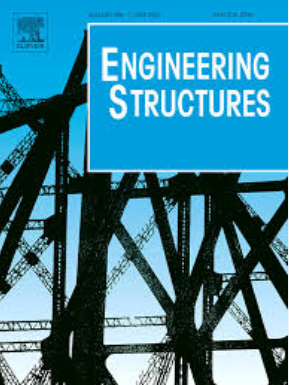方柱在横向冲击下的两阶段动力剪切响应:机理、惯性力分析和冲剪抗力模型
IF 6.4
1区 工程技术
Q1 ENGINEERING, CIVIL
引用次数: 0
摘要
钢筋混凝土(RC)柱是易受横向冲击载荷(例如车辆碰撞、船舶撞击)影响的关键部件,但现有研究未能充分解决动态条件下冲剪和斜剪破坏之间的不同抗剪机制,以及它们对评估方法的影响。为了解决这些问题,本研究通过高保真有限元(FE)模拟系统地研究了方形RC柱的动态剪切行为,并通过摆锤冲击试验进行了验证,重点研究了两阶段剪切机制、惯性力和参数效应。仿真结果表明,RC柱的冲击响应可分为两个不同的阶段:以冲击点上下截面力同步增长为特征的局部响应阶段和以弯剪相互作用为特征的整体响应阶段。剪切塞内的动态剪切力峰值在超过临界阈值后随着冲击速度的增加而减小,这与两种机制的过渡基本一致。参数分析揭示了剪切阻力对冲击速度、剪切跨比、边界条件、轴压比和截面尺寸的敏感性。关键是,剪切塞的惯性力被证明与峰值冲击力和剪切塞质量相关,从而开发出半经验惯性力公式。在此基础上,建立了明确考虑惯性力的局部阶段冲切阻力分析模型,并通过80个实验和数值算例进行了验证。这项工作促进了对动态抗剪机制的理解,并提供了一个有效的分析框架,用于预测侧向冲击RC柱的冲剪破坏,提供了机理见解和实际设计意义。本文章由计算机程序翻译,如有差异,请以英文原文为准。
Two-stage dynamic shear response of square RC columns under lateral impact: Mechanisms, inertial force analysis, and punching shear resistance model
Reinforced concrete (RC) columns are critical components vulnerable to lateral impact loads (e.g., vehicle collisions, ship strikes), yet existing studies inadequately address the distinct shear resistance mechanisms between punching shear and diagonal shear failures under dynamic conditions, as well as their implications for assessment methodologies. To address these gaps, this study systematically investigates the dynamic shear behavior of square RC columns through high-fidelity finite element (FE) simulations validated against pendulum impact tests, with emphasis on two-stage shear mechanisms, inertial forces, and parametric effects. The simulation results indicate that the impact response of RC columns can be divided into two distinct stages: a local response stage characterized by the synchronous growth of the forces in the upper and lower sections at the impact point and a global response stage governed by flexural-shear interactions. The peak dynamic shear force in the shear plug decreases with increasing impact velocity beyond a critical threshold, which is essentially consistent with the transition between these two mechanisms. Parametric analyses reveal the sensitivity of shear resistance to impact velocity, shear-to-span ratio, boundary conditions, axial compression ratio, and cross-sectional dimensions. Crucially, the inertial force of the shear plug is proven to correlate with both the peak impact force and the shear plug mass, enabling the development of a semi-empirical inertial force formula. Furthermore, an analytical model for predicting the punching shear resistance in the local stage is proposed, explicitly incorporating inertial forces and validated against 80 experimental and numerical cases. This work advances the understanding of dynamic shear resistance mechanisms and provides a validated analytical framework for predicting punching shear failures in laterally impacted RC columns, offering both mechanistic insights and practical design implications.
求助全文
通过发布文献求助,成功后即可免费获取论文全文。
去求助
来源期刊

Engineering Structures
工程技术-工程:土木
CiteScore
10.20
自引率
14.50%
发文量
1385
审稿时长
67 days
期刊介绍:
Engineering Structures provides a forum for a broad blend of scientific and technical papers to reflect the evolving needs of the structural engineering and structural mechanics communities. Particularly welcome are contributions dealing with applications of structural engineering and mechanics principles in all areas of technology. The journal aspires to a broad and integrated coverage of the effects of dynamic loadings and of the modelling techniques whereby the structural response to these loadings may be computed.
The scope of Engineering Structures encompasses, but is not restricted to, the following areas: infrastructure engineering; earthquake engineering; structure-fluid-soil interaction; wind engineering; fire engineering; blast engineering; structural reliability/stability; life assessment/integrity; structural health monitoring; multi-hazard engineering; structural dynamics; optimization; expert systems; experimental modelling; performance-based design; multiscale analysis; value engineering.
Topics of interest include: tall buildings; innovative structures; environmentally responsive structures; bridges; stadiums; commercial and public buildings; transmission towers; television and telecommunication masts; foldable structures; cooling towers; plates and shells; suspension structures; protective structures; smart structures; nuclear reactors; dams; pressure vessels; pipelines; tunnels.
Engineering Structures also publishes review articles, short communications and discussions, book reviews, and a diary on international events related to any aspect of structural engineering.
 求助内容:
求助内容: 应助结果提醒方式:
应助结果提醒方式:


